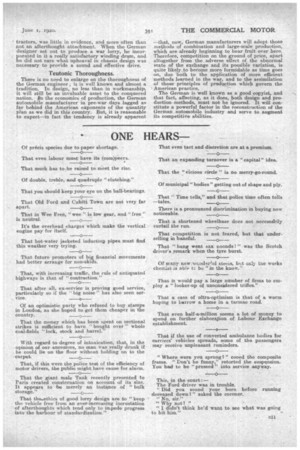GERMANY'S POST-WAR PRODUCTS.
Page 2

Page 3

If you've noticed an error in this article please click here to report it so we can fix it.
SIGNS ARE NOT wanting that, before long, the competition of German vehicles will have to be considered once again, and it may, therefore; be not inopportune to consider some of the aspects of German heavy vehicle design as compared with our own. To the critical observer the designs of every country exhibit, to a greater or lesser extent, in almost every ease, the national characteristics of the nation to Which they belong. It is so with our own productse and those of America, France, and Italy, all Possessdistinctive traits, which reflect the temperament and psychology of the producing nation. Similarly, in the case of German design, we. see tendencies which can be directly attributed to those national characteristics which we naturally associate with the country of its origin. In German automobile design we generally find sound technical principles, embodied in a type of construction which has none of the. artistry, say, of the Italian. There is a certain crudeness, a kind of drastic treatment, which come almost naturally from a people who so readily embraced a policy of frightfulnese-in other things. Not that German design is " frightful," it is not, but, in designing any particular feature, the German designer seems often to take the shortest cut to achieving the desired result, without caring very much for the: look of the thing, and he exhibits thereby a certain contempt for outside opinion, which is, after all, only what past experience of German mentality would lead one to expect. There is a directness and decision in the b10
way the problems of design are tackled. Thus, although, in some respects, the German vehicle is crude as regards design of its details, it is a sueace erudeneast only—the crudeness of apPearance, and that fact must not lead anyone to regard the German automobile as -a thing to be reckoned with lightly.
The Question of Ingenuity.
Nor must it be imagined that German design, -if exhibiting crudeness, lacks ingenuity. The war brought forward mach evidence to the contrary. Those vehicles, and they were many and various, which were captured from the enemy, testified to a capacity for rapid improvisation—where shortage of materials and‘special conditions made it necessary— and an appreciation of the special features of design called for by war conditions that was quite praiseworthy, and often compelled the reluctant admiration of their adversaries. Most of the .German war lorries and tractors were, MaJoubteelly, more expressly designed for the purposes of war-than were our own, and, moreover, they were not all pre-war deeigna Known to have been produced during the progress of hostilities', many of them gave evidence of tremendous designing activity and freshness of thought in tackling the special problems to he met. In this, as in other matters, drastic treatnient was demanded and it was furnished bythe Geeene.n. designer. To take, for instance, the matter of winding drums, very few, if any, British lorries were well equipped in this respect. In the British army, the wielding drum, although specially fitted to some gun tractors, was little in evidence, and mor often than not an afterthought attachment. When the German designer set out to produce a war lorry, he incorporated in it a really satisfactory winding drum, and he did not care what upheaval in chassis design was necessary to provide a sound and effective drive. .
Teutonic Thoroughness.
There is no need to enlarge on the thoroughness of the German engineer; it is well known and almost a tradition. In design, no less than in workmanship, it will still be an invaluable asset to the conquered nation. In the economics of production, the German automobile manufacturer in pre-war days lagged as far behind the Ameriean exponents of the quantity plan as-we did in this country. But, it is reasonable to expect—in fact the tendency is already apparent —that, now, German manufacturers will adopt those methods of combination and large-scale production, which are already beginning to bear fruit over here. Therefore, competition on the ground of price, apart altogether from the adverse effect of the abnormal state of the exchange and its possible variation, is quite likely to become more formidable as time goes on, due both to the application of more efficient methods learned in the war, and to the assimilation of those principles of production which govern the American practice. The German is well known as a good copyist, and that fact, affecting, as it does, both design and production methods, must not be ignored. It will constitute a powerful factor in the reconstruction of the German, automobile industry and serve to augment its competitii7e abilities.




























